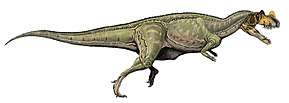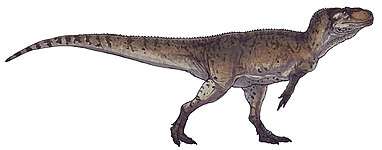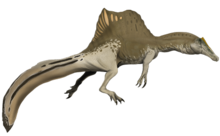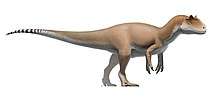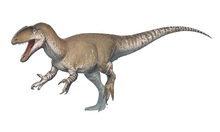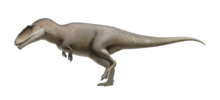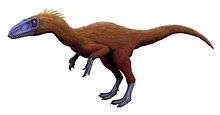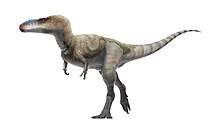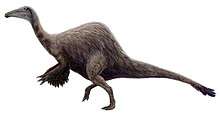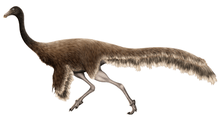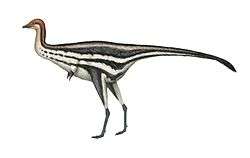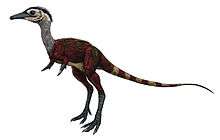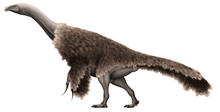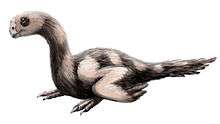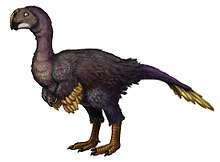Hagryphus
Hagryphus ("Ha's griffin"), is an oviraptorosaurian theropod dinosaur from the Upper Cretaceous Period of what is now Utah.
| Hagryphus | |
|---|---|
| Reconstructed skeleton based on the related Anzu wyliei, Natural History Museum of Utah | |
| Scientific classification | |
| Kingdom: | Animalia |
| Phylum: | Chordata |
| Clade: | Dinosauria |
| Clade: | Saurischia |
| Clade: | Theropoda |
| Family: | †Caenagnathidae |
| Genus: | †Hagryphus Zanno & Sampson, 2005 |
| Type species | |
| †Hagryphus giganteus Zanno & Sampson, 2005 | |
Discovery and naming
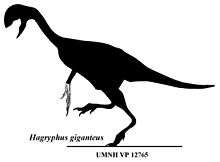
To date, only a single species of Hagryphus has been named in 2005 by Lindsay Zanno and Scott Sampson, the type species Hagryphus giganteus. The generic name is derived from Egyptian Ha, the name of the god of the western desert and a Latinised Greek γρύψ (gryps) meaning 'griffin' (a mythological bird-like creature). The specific name means "gigantic" in Latin.[1]
The holotype was discovered in 2002 by Michael Getty in the Kaiparowits Formation (Late Campanian) in the Grand Staircase-Escalante National Monument of southern Utah. The find was scientifically reported in 2003.[2] Radiometric dating of rocks from slightly below the rock bed where the fossil was found indicates that the specimen died 75.95 million years ago.[3] Designated UMNH VP 12765, the type specimen resides in the collections of the Utah Museum of Natural History in Salt Lake City. It consists of an incomplete but articulated left manus and the distal portion of the left radius. The hand lacks the second claw. In the wrist both the semilunate carpal bone and the radiale are preserved. Also some fragmentary foot elements, found at the hillside near the hand, have been catalogued under the same inventory number.[1]
Description
As the specific name indicates, Hagryphus giganteus was a particularly large oviraptorosaur, estimated by the describers to have been approximately three meters (10 ft) long, which makes it one of the largest members of the clade Oviraptorosauria (Barsbold, 1976), apart from the later described Gigantoraptor. H. giganteus was estimated to have been 30-40% larger than the next largest known North American oviraptorosaur, Chirostenotes. The hand of the holotype was about a foot long.[1] However, later estimates have been lower: Gregory S. Paul in 2010 gave a length of eight feet and a weight of fifty kilogrammes.[4]
Phylogeny
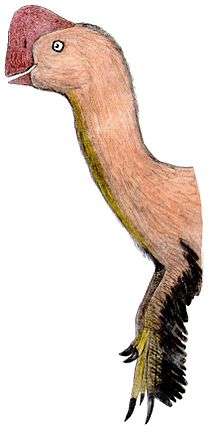
In 2003 Zanno & Sampson reported the new find as a member of the Caenagnathidae.[2] However, in 2005 they limited the precision of the determination to a more general Oviraptorosauria. Hagryphus would then be the southernmost known oviraptorosaurian from the Americas.[1]
Other known species of North American oviraptorosaurs include Elmisaurus rarus, Microvenator celer, and Chirostenotes pergracilis. This group of dinosaurs is better known from the Cretaceous of Asia, where forms such as Khaan mckennai, Conchoraptor gracilis and Oviraptor philoceratops have been discovered.
Oviraptorosaurs are characterized by a shortened snout, massive endentulous jaws and extensively pneumatized skulls, often sporting elaborate crests, the function of which remains unknown. The toothless jaws have indicate to some a diet of eggs but these theropods more likely fed on plants or small vertebrates. Evidence suggests that they were feathered and some paleontologists consider them to be true birds (see the main article Oviraptorosauria for further information).
Paleoecology
Habitat
The only known specimen of Hagryphus was recovered at the Kaiparowits Formation, in southern Utah. Argon-argon radiometric dating indicates that the Kaiparowits Formation was deposited between 76.1 and 74.0 million years ago, during the Campanian stage of the Late Cretaceous period.[5][6] During the Late Cretaceous period, the site of the Kaiparowits Formation was located near the western shore of the Western Interior Seaway, a large inland sea that split North America into two landmasses, Laramidia to the west and Appalachia to the east. The plateau where dinosaurs lived was an ancient floodplain dominated by large channels and abundant wetland peat swamps, ponds and lakes, and was bordered by highlands. The climate was wet and humid, and supported an abundant and diverse range of organisms.[7] This formation contains one of the best and most continuous records of Late Cretaceous terrestrial life in the world.[8]
Paleofauna
Hagryphus shared its paleoenvironment with theropods such as dromaeosaurids, the troodontid Talos sampsoni, ornithomimids like Ornithomimus velox, tyrannosaurids like Albertosaurus and Teratophoneus, armored ankylosaurids, the duckbilled hadrosaurs Parasaurolophus cyrtocristatus and Gryposaurus monumentensis, and the ceratopsians Utahceratops gettyi, Nasutoceratops titusi and Kosmoceratops richardsoni.[9] Paleofauna present in the Kaiparowits Formation included chondrichthyans (sharks and rays), frogs, salamanders, turtles, lizards and crocodilians. A variety of early mammals were present including multituberculates, metatherians, and eutherians.[10]
See also
Notes
- Zanno, L. E.; Sampson, S. D. (2005). "A new oviraptorosaur (Theropoda; Maniraptora) from the Late Cretaceous (Campanian) of Utah". Journal of Vertebrate Paleontology. 25 (4): 897–904. doi:10.1671/0272-4634(2005)025[0897:anotmf]2.0.co;2.
- Zanno, L.E.; Sampson, S.D. (2003). "A new caenagnathid specimen from the Kaiprowits Formation (Late Campanian) of Utah". Journal of Vertebrate Paleontology. 23 (3): 114A. doi:10.1080/02724634.2003.10010538.
- Lindsay E. Zanno; David J. Varricchio; Patrick M. O'Connor; Alan L. Titus; Michael J. Knell (2011). "A new troodontid theropod, Talos sampsoni gen. et sp. nov., from the Upper Cretaceous Western Interior Basin of North America". PLoS ONE. 6 (9): e24487. doi:10.1371/journal.pone.0024487. PMC 3176273. PMID 21949721.
- Paul, G.S., 2010, The Princeton Field Guide to Dinosaurs, Princeton University Press p. 150
- Roberts EM, Deino AL, Chan MA (2005) 40Ar/39Ar age of the Kaiparowits Formation, southern Utah, and correlation of contemporaneous Campanian strata and vertebrate faunas along the margin of the Western Interior Basin. Cretaceous Res 26: 307–318.
- Eaton, J.G., 2002. Multituberculate mammals from the Wahweap(Campanian, Aquilan) and Kaiparowits (Campanian, Judithian) formations, within and near Grand Staircase-Escalante National Monument, southern Utah. Miscellaneous Publication 02-4, Utah Geological Survey, 66 pp.
- Titus, Alan L. and Mark A. Loewen (editors). At the Top of the Grand Staircase: The Late Cretaceous of Southern Utah. 2013. Indiana University Press. Hardbound: 634 pp.
- Clinton, William. "Preisdential Proclamation: Establishment of the Grand Staircase-Escalante National Monument". September 18, 1996. Archived from the original on 28 August 2013. Retrieved 9 November 2013.
- Zanno, Lindsay E.; Sampson, Scott D. (2005). "A new oviraptorosaur (Theropoda; Maniraptora) from the Late Cretaceous (Campanian) of Utah". Journal of Vertebrate Paleontology. 25 (4): 897–904. doi:10.1671/0272-4634(2005)025[0897:ANOTMF]2.0.CO;2.
- Eaton, Jeffrey G.; Cifelli, Richard L.; Hutchinson, J. Howard; Kirkland, James I.; Parrish, J. Michael (1999). "Cretaceous vertebrate faunas from the Kaiparowits Plateau, south-central Utah". In Gillete, David D. (ed.). Vertebrate Paleontology in Utah. Miscellaneous Publication 99-1. Salt Lake City: Utah Geological Survey. pp. 345–353. ISBN 1-55791-634-9.
References
- Barsbold, Rinchen (1976). "[A new Late Cretaceous family of small theropods (Oviraptoridae n. fam.) in Mongolia]". Doklady Akademii Nauk SSSR. 226 (3): 685–688.
External links
| Wikimedia Commons has media related to Hagryphus. |
